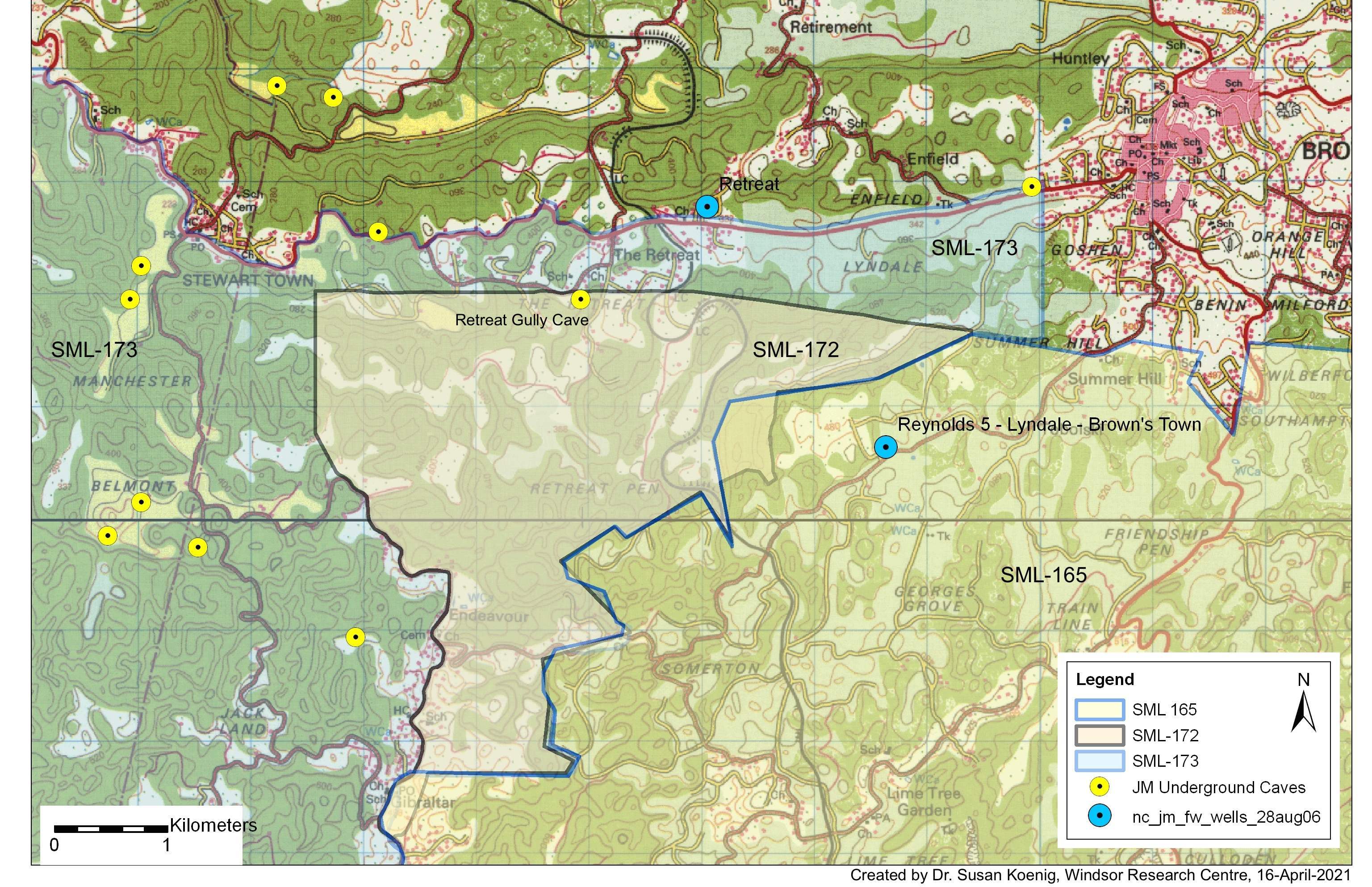On August 28th, 2018, with the signature of the Minister of Transport & Mining, Robert Montague, Special Mining Lease (SML) 173
was granted to New Day Aluminum (Jamaica) Ltd.
This represents a breach because before an SML can be issued, it must first have an Environmental Permit from NEPA / NRCA. And for this, NEPA has required an
Environmental Impact Assessment (EIA).
To assist the public in monitoring the process, WRC has created this "hub" page with links to the EIA and to reviews which Dr. Koenig and others have prepared.
NEW UPDATES: January 25th 2022
Following NEPA's posting of a so-called final version of the EIA for SML-173 (document dated August 3rd, 2021) and a public meeting held on November 16th, 2021,
we have updated this hub-page. Under the section of TECHNICAL REVIEWS below, we have added Dr. Susan Koenig's and Ms. Heather Kostick's reviews of the "final" version of the EIA.
Last updated: 25-January-2022
Please check regularly for updates.
Click here for SML-173 (incl. map), which was issued on August 28th, 2018.
Users should contact Mines & Geology Division (GoJ) to check for any amendments to this lease. As per the EIA, no amendments had been made up-to 6-November-2020.
Click here for an explanation of inconsistencies in SML-173. These relate to the lease's statement that
the area delineated for mining is “approximately One Hundred and Twenty square kilometres (120 km2)" and that the area already assigned on 16-May-2017 to another lease,
SML-172, was included in SML-173.
For the EIA and associated documents, visit NEPA's website https://www.nepa.gov.jm/environmental-impact-assessments
Title: Proposed mining operations at SML 173 (St. Ann & Trelawny) by Noranda Jamaica Bauxite Partners II
TECHNICAL REVIEWS (click on links):
WRC's Dr. Susan Koenig's review; expertise - Cockpit Country
WRC's Dr. Susan Koenig's review of the so-called "final" version dated August 3rd, 2021 and of the public meeting held on November 16th, 2021
Dr. Brock Fenton's review; expertise - bats
Heather Kostick's review; expertise - snails
Heather Kostick's review of the so-called "final" version dated August 3rd, 2021
EXTRA & RELEVANT: Dr. Susan Koenig's review of an EIA for SEPL-524 (east-central St. Ann but also in cockpit karst);
scroll to bottom of this page to see a map of SEPL-524's position
Reviews from various government entities were obtained by Jamaica Environment Trust (JET*) using Access-to-Information requests:
Water Resources Authority (GoJ):
WRA_2018-03-12.pdf (Noranda's proposal to apply for an EP)
WRA_2019-08-30.pdf (comments on EIA)
WRA_2020-03-19.pdf (comments on revised EIA)
WRA_2020-12-15.pdf (comments on revised EIA; comprehensive review)
WRA_2021-03-24.pdf (comments following meeting with EIA consultants)
Forestry Department (GoJ):
FD_2020-03-23.pdf (comments on EIA)
FD_2021-01-05.pdf (comments on revised EIA)
FD_2021-05-06.pdf (list of documents from FD requested by JET)
National Works Agency (GoJ):
NWA_2020-12-22.pdf (notification that application is being returned because processing fee is outstanding)
NWA_2021-02-24.pdf (notification that processing fee and traffic management plant remain outstanding)
Mines and Geology Division (GoJ):
MGD_2019-10-25.pdf (comments on EIA)
MGD_2021-01-25.pdf (comments on revised EIA)
*The link to JET also takes you to links the the 2020 publication Red Dirt: Inheritance or Commodity,
a multidisciplinary review of the bauxite-alumina industry in Jamaica.
Dr. Susan Koenig's chapter in the book is entitled "Degradation of Ecological Heritage: The Impact of Bauxite Mining on Karst Ecosystems in Jamaica."
In WRA's reviews, the agency makes reference to a well at Retreat (St. Ann) and notes that the well has been contaminated by an "unknown source."
Using WRA's online Water Information System database, we downloaded information about this well and provide those documents here for
people who might not find it easy to navigate WRA's database:
Groundwater Level Data - Monthly (these are the monthly averages for 3 months (Feb-Apr) in 1972 and from January 2001 through December 2019; no files could be found to indicate any monitoring of
contaminants which would affect water quality)
Well Lithology (description of the geology as it changes from the surface to a depth of 635 feet)
Well Record (drilled by Kaiser Bauxite Company, size of well, etc.)
We draw your attention to the Well Record, which included remarks that the well was:
Used for domestic purposes to supply Kaiser re-settlement families.
Abandoned due to pollution. Now an index well (CHC 2001).
As the source of the pollution is "unknown", WRC can't help but wonder if it was related to mining in the area which is currently under SML-165 but which also was mined in the 1960s / 70s or if it
was in some way associated with the railway line which is < 500 meters from the well and which transports the bauxite to Discovery Bay. We're working to find someone from the area who can remember when the
well was drilled and its history.
We also note that it appears that families resettled by Kaiser might be subjected to new mining under SML-172 or SML-173 if the latter were to be approved.
Notice that the Retreat Well is just barely outside (north) of the boundary of SML-173.
We also note that, as per Water Resource Authority's 2019 Water Quality Atlas, there aren't any wells within SMLs 165, 172 or 173 which WRA uses to monitor pollution of groundwater.
Indeed, there is only one well located in Browns Town which appears to be used to monitor for pollution of the limestone aquifer associated with these mining leases.
The November 6, 2020 EIA confirms our observations. From page 11-6:
"There are no wells close to the Cockpit Country or the SML 173 area that can be monitored for either groundwater levels or water quality . . .
. . .Monitoring of water quality will have to be done at Dornoch the head of the Rio Bueno River.
The monitoring of water quality should include parameters that can be done by local laboratories and should include pre-mining, operational and post mining monitoring."
For WRC, this begs two questions of how pollution (water quality) and changes in groundwater levels and flow regimes are going to be detected in the absence of any
pre-mining baseline data collected at the appropriate temporal- and spatial-resolution:
Q1: What in the minimum timeframe karst hydrologists recommend for collecting pre-mining baseline data so that flash-pulse events and seasonal, annual, and El Nino-Southern Oscillation (ENSO) patterns are correctly documented?
Q2: What would a karst hydrologist recommend as an appropriate spatial distibution for monitoring stations?




